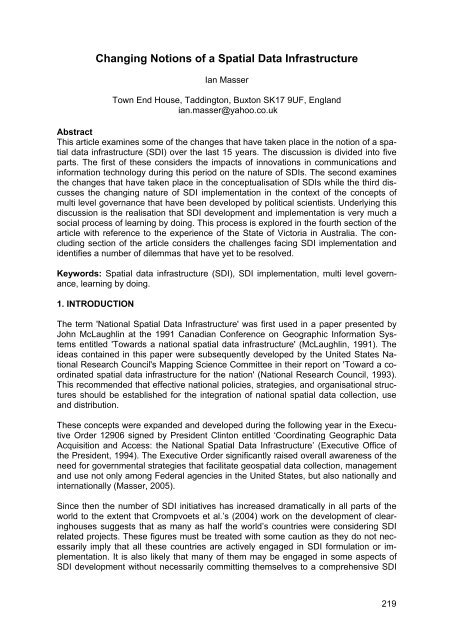SDI Convergence - Nederlandse Commissie voor Geodesie - KNAW
SDI Convergence - Nederlandse Commissie voor Geodesie - KNAW
SDI Convergence - Nederlandse Commissie voor Geodesie - KNAW
Create successful ePaper yourself
Turn your PDF publications into a flip-book with our unique Google optimized e-Paper software.
Changing Notions of a Spatial Data Infrastructure<br />
Ian Masser<br />
Town End House, Taddington, Buxton SK17 9UF, England<br />
ian.masser@yahoo.co.uk<br />
Abstract<br />
This article examines some of the changes that have taken place in the notion of a spatial<br />
data infrastructure (<strong>SDI</strong>) over the last 15 years. The discussion is divided into five<br />
parts. The first of these considers the impacts of innovations in communications and<br />
information technology during this period on the nature of <strong>SDI</strong>s. The second examines<br />
the changes that have taken place in the conceptualisation of <strong>SDI</strong>s while the third discusses<br />
the changing nature of <strong>SDI</strong> implementation in the context of the concepts of<br />
multi level governance that have been developed by political scientists. Underlying this<br />
discussion is the realisation that <strong>SDI</strong> development and implementation is very much a<br />
social process of learning by doing. This process is explored in the fourth section of the<br />
article with reference to the experience of the State of Victoria in Australia. The concluding<br />
section of the article considers the challenges facing <strong>SDI</strong> implementation and<br />
identifies a number of dilemmas that have yet to be resolved.<br />
Keywords: Spatial data infrastructure (<strong>SDI</strong>), <strong>SDI</strong> implementation, multi level governance,<br />
learning by doing.<br />
1. INTRODUCTION<br />
The term 'National Spatial Data Infrastructure' was first used in a paper presented by<br />
John McLaughlin at the 1991 Canadian Conference on Geographic Information Systems<br />
entitled 'Towards a national spatial data infrastructure' (McLaughlin, 1991). The<br />
ideas contained in this paper were subsequently developed by the United States National<br />
Research Council's Mapping Science Committee in their report on 'Toward a coordinated<br />
spatial data infrastructure for the nation' (National Research Council, 1993).<br />
This recommended that effective national policies, strategies, and organisational structures<br />
should be established for the integration of national spatial data collection, use<br />
and distribution.<br />
These concepts were expanded and developed during the following year in the Executive<br />
Order 12906 signed by President Clinton entitled ‘Coordinating Geographic Data<br />
Acquisition and Access: the National Spatial Data Infrastructure’ (Executive Office of<br />
the President, 1994). The Executive Order significantly raised overall awareness of the<br />
need for governmental strategies that facilitate geospatial data collection, management<br />
and use not only among Federal agencies in the United States, but also nationally and<br />
internationally (Masser, 2005).<br />
Since then the number of <strong>SDI</strong> initiatives has increased dramatically in all parts of the<br />
world to the extent that Crompvoets et al.’s (2004) work on the development of clearinghouses<br />
suggests that as many as half the world’s countries were considering <strong>SDI</strong><br />
related projects. These figures must be treated with some caution as they do not necessarily<br />
imply that all these countries are actively engaged in <strong>SDI</strong> formulation or implementation.<br />
It is also likely that many of them may be engaged in some aspects of<br />
<strong>SDI</strong> development without necessarily committing themselves to a comprehensive <strong>SDI</strong><br />
219

















